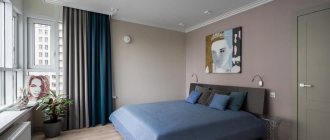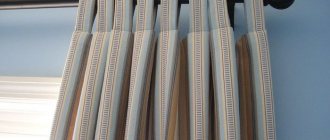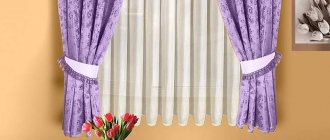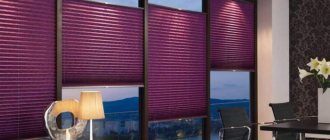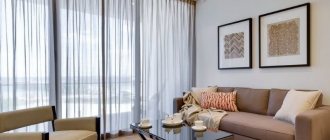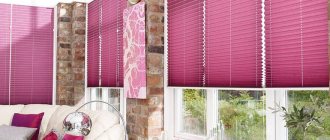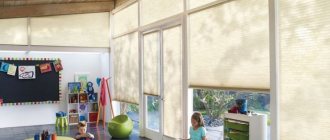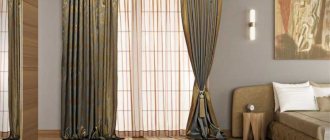Textiles can greatly enhance the style of any room. Curtains have become an integral part of the interior.
They can be dense, heavy, draw attention to themselves, or they can create the effect of lightness and weightlessness. Draping curtains turns a simple fabric into an unusual product.
A purchased ready-made version of the curtain may turn out to be completely inappropriate in the existing room.
In this case, draping curtains with your own hands can correct the situation. You will need very little for this:
- curtain fabric;
- threads, curtain tape;
- decorative elements (cords, tassels, beads).
Advantages of curtain tape
Previously, curtains were attached to the cornice in different ways: loops were sewn on by hand, metal clips were used, which could damage the material, and rings were used.
With the advent of curtain tape, hanging a curtain is very easy. In addition, using tape you can create different options for draping curtains.
With the advent of a special braid, it became possible to change the height of the curtain without much effort. Thanks to several rows of loops, it is enough to fasten the hooks on the row above or below.
The canvas holds its shape better and remains in its original form longer. After washing, it will not be difficult to restore the curves of the curtains on the cornice. With the right choice of color and method of draping the canvas, you can decorate the window opening of any interior.
Using the tape is very simple. It is sewn at a small (0.2 - 0.5 cm) distance from the top edge from the wrong side. Draperies are formed using cords, pulling the fabric from the edge to the center.
The main condition is a sufficient margin of curtain width. For all cornice design options, you need at least two widths of fabric. For more magnificent and ceremonial options, a build factor of 2.5-3 is often required.
Colors and patterns
When choosing the color scheme and pattern of curtains, you need to focus on the overall color scheme of the room, the upholstery and texture of the furniture and accessories (read about curtains in the color of the furniture here). The drapery on the windows should be in harmony with other textile elements in the room.
Curtains without ornaments will be appropriate in any interior. If you prefer patterned curtains, you need to carefully consider the color scheme, motif and proportions of the pattern. It should fit harmoniously into the style of the room and be combined with other decorative elements.
A small room should be decorated with fabric with small patterns, and a large room can be decorated with curtains with large, bright patterns.
When choosing the color scheme of the drapery, you must take into account the size of the room. Light shades of a cold range will fill the room with freshness and coolness, visually enlarging the space: white, gray. Spacious rooms allow the use of more saturated colors. The combination of dark brown and beige, terracotta and gold will create an atmosphere of respectability and home comfort. Green shades will look good in both large and small spaces.
Decor options
Drapery consists of different fold options. They can be laid to one side at equal intervals (this is one of the simplest options).
If you want to create something original, you need to use your imagination and play with the canvas. The folds can be laid towards each other (counter), or vice versa, using paired bends to form flat bows.
The thickness of the tape and the number of cords for broaches depend on the method of decoration and the density of the fabric. Some options are formed directly on the cornice after the curtain is already hanging. This creates loop-shaped folds. The main thing is to maintain the same distance between them.
Beautiful drapery of curtains is obtained if you use a special thin cord to form folds. This option is called Flemish. You can lay folds in the form of geometric shapes. For example, buffalo ones resemble diamonds.
Application in the interior
Bedroom
An abundance of draperies, soft folds, smooth lines and curves are appropriate in the bedroom. A classic bedroom will be decorated with lambrequins and cascading drapery; for a room in a modern style, pleated sliding curtains with eyelets or hinges are suitable. On small windows, lifting models look organic: Austrian, Roman or roller blinds. Large and wide window openings can be decorated with complex drapery with lambrequins and other decorative elements.
Living room
Lush draperies and folds can transform the interior of the hall and make it more solemn. For the living room, dense, expensive fabrics that lend themselves well to draping are suitable. Curtains for the living room should combine elegant elegance and a sense of homeliness.
Children's
An ideal option for a child’s room is classic curtains made from natural fabrics. In this room, you should not create complex draperies on the windows. While playing, kids can damage the composition by tearing the curtains from their loops. These curtains are more suitable for a teenager.
Kitchen
Most of the kitchen space is occupied by furniture and appliances; lush curtains with folds would be inappropriate here. Owners of small kitchens should consider more practical options: roller blinds or Roman blinds. In a spacious kitchen with a dining area, you can hang a classic floor-length curtain.
General information about curtains
- A curtain is a canvas made of dense fabric, on which there is a pattern or embroidery in combination with drapery. Initially, they were decorations for doorways, and they protected the room from drafts.
- The curtain is an integral part of curtains made in classic and modern styles.
- Curtains can perform not only a decorative function, they perfectly protect owners from the sun and prying eyes
Over time, people realized that due to the characteristics of the fabric used, they can also protect from bright sunlight, as well as from extraneous noise. It is thanks to these properties that curtains are so popular today.
The main functions are:
- regulation of light flux;
- preventing rooms from being viewed from the street;
- giving the window opening beauty and expressiveness.
If to perform the first two functions it is enough to choose thick fabric for curtains, then to perform the decorative function it is recommended to listen to the recommendations of designers.
Pasting
Behind the complexity of the work there is always a wonderful result, distinguished by its high cost and noble appearance. So, covering walls with fabric falls specifically into this category. After all, from the outside, the interior with such walls looks like it has very expensive luxurious wallpaper.
In order for the result to correspond to the complexity of the work and the effort expended, the walls should be carefully prepared. Although the texture of the material can hide small errors, due to the complexity of the work and the high cost of the fabric, it is not worth the risk. The walls are leveled, puttied and covered with primer.
The textile itself also requires preparation. Gluing wide rolls of fabric to the wall is a very difficult process. Therefore, the fabric is cut into strips and slightly longer than 5-7 cm, the height of the walls. Before gluing it should be soaked in water, dried and ironed. This will help avoid shrinkage during drying after gluing.
During the work, you should pay special attention to the joints. As with wallpaper, to obtain the effect of a single canvas, the fabric is glued at the joint with precise adherence to the pattern.
Textile wallpaper is an excellent alternative for covering walls. After all, the final result will be exactly the same as in the method described above. The only difference is that they have a vinyl or non-woven base. This greatly simplifies the gluing process: there is no need to cut or soak the fabric. And when working with such a substrate, everything is much simpler.
Some nuances when finishing
Having studied all the advantages of textile wall decoration, we can conclude that it is not demanding and is convenient even for non-professionals. But, nevertheless, before you begin the decorating process, you need to take into account the following nuances:
- The room in which the walls are supposed to be draped with fabric should be at an optimal temperature of 20⁰C and an acceptable humidity level of 80%.
- The amount of material is adjusted according to the parameters of the walls. But it’s worth buying a little more textiles, since the excess will be useful for post-repair adjustments or for the restoration of mechanical and other damage.
- If on ordinary wallpaper seams at the joints are a common thing, then on woven material their presence is not desirable. Therefore, the width of the canvas should be equal to the height of the ceiling. This will prevent the appearance of seams.
Taking into account simple rules will allow you to achieve the ideal when draping walls.
Removing seams Source img.wallpapersafari.com
See also: Catalog of house projects in the Art Nouveau style.
Fabric stretching
At first glance, covering walls with decorative fabric looks like a fairly simple, harmless job. The catch is that to obtain the desired flat surface, you need to build a frame around the perimeter of each wall. For these purposes, it is ideal to use wooden slats. In this case, the canvas should be large to avoid joints, but it is also necessary to leave a margin. Without this, it will not be possible to stretch the canvas onto the slats. the tension method is considered the simplest of all. After all, there is no need for careful preparation of the walls. It is enough to remove dust and seal the cracks.
It is worth noting that segmental tension also occurs if the design of the room allows such a solution. This technique of decorating a wall with fabric involves creating several rectangular panels of the same or different sizes. Next, they are hung on special hooks mounted on the wall and assembled like a puzzle.
Practical advice
Before purchasing fabric for curtains, several main factors are taken into account:
- practical and aesthetic purpose of the room;
- general style of the room;
- ceiling height, size and location of windows.
Decide on the main functions of curtains for the room
Will they protect from sunlight and dust or is it important for them to keep warm in the winter? Sometimes they are used to mask the imperfections of a window opening, increase or decrease the size of the window, and visually raise the ceiling. Take a close look at your window and decide what you would like to bring into your space.
When choosing a fabric, immediately pay attention to softness and pliability for drapery. General recommendations:
General recommendations:
- For the sunny side, choose fabrics impregnated with a protective agent against fading in the sun.
- To retain heat during the cold season, dense fabrics with a wool lining are used. In the summer, such curtains are removed, replacing them with light, lace options.
- The most practical curtains are made of polyester (a small admixture of cotton is allowed). This material does not deteriorate during washing (at temperatures up to 40 degrees).
- The most capricious and sensitive to external influences are fabrics: velvet, linen and cotton; they can only be cleaned dry.
Ceiling drapery
This type of finishing is not new; it was used in ancient times. Textiles can cover the ceiling completely or partially, in the form of stripes, domes, ribbons, rectangular or square segments, canopies, etc., depending on the purpose.
The advantages of decorating the ceiling with draped fabric are approximately the same as for walls. But the disadvantages are much more serious.
- Firstly, a ceiling that is draped and not covered with textiles immediately becomes much lower visually. And if the drapery is voluminous, sagging, reminiscent of sails, then in fact. Therefore, the initial height of the room for such finishing should be at least 2.7 meters.
- Secondly, such a ceiling is much more difficult to fit into the interior so that it does not hang like an alien structure, but blends harmoniously into the decor. You will have to study the chosen style and select the fabric more thoroughly.
- Thirdly, fabric is a flammable, fire hazardous material. This means that either it is chosen with high-quality fireproof impregnation (and this is a different price level), or you need to worry about the quality of the wiring and lamps.
- Fourthly, removing the material for washing and then putting it back in place is also much more difficult than hanging it on the wall.
In children's rooms, bathrooms and kitchens, draped ceilings are also not appropriate.
Draping curtains
Window decoration today receives great attention. They can be either the logical conclusion of the overall picture or an organizing accent in the interior. To sew a properly draped window treatment, you should consider what styles of drapery there may be and how they differ.
- Baroque, Rococo, Neoclassicism, Classical style, Empire style - styles of expensive palace luxury. Rich textiles are used for curtains: velvet, silk, brocade with woven gold threads, moire, taffeta. The canvases are trimmed with gold lace and complemented with lambrequins - complex, even carved; tiebacks, holders, cords, tassels, fringe.
- Art Nouveau involves floral ornaments, simple forms of draperies in light pink, green, blue, lilac, yellow tones.
- Art Deco is predominantly straight canvases made of expensive fabrics with large patterns, generously trimmed with borders. Typical color combinations are: black with orange, gold with blue.
- Country, Provence, shabby chic. These styles are characterized by rustic simplicity and the use of natural fabrics such as cotton, linen, and silk. The curtains are cute, cozy models with folds, frills, lace trim (cafe curtains, curtains with tiebacks, hourglasses, simple lambrequins, multi-layer curtains).



